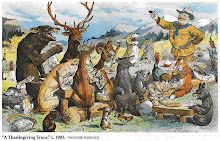Cattlemen: Relax wolf protections
Leader wants USDA Wildlife Services to determine cause of livestock losses
By MITCH LIES
Capital Press
HILLSBORO, Ore. -- Oregon Cattlemen's Association President Bill Hoyt is urging the Oregon Fish and Wildlife Commission to give ranchers more authority to manage problem wolves.
"We want this (Oregon wolf) plan to be a reasonable management plan," Hoyt said to commissioners at a Sept. 2 meeting.
Environmentalists, conversely, are urging commissioners to strengthen wolf protections.
The state Fish and Wildlife Commission plans to update the 2005 Oregon Wolf Conservation and Management Plan at its next meeting Sept. 30 in Bend.
Under the state's plan, four breeding pairs must inhabit Oregon for three years before the state relaxes wolf protections. Currently, one breeding pair, two wolf packs and 20 wolves inhabit Oregon, according to state biologists.
The state plan would kick in only if the Northern Rocky Mountain gray wolf is removed from the federal endangered species list.
The U.S. Fish and Wildlife Service delisted the wolf in 2009, but a U.S. District Court judge in Montana in August relisted the wolf.
Hoyt and Oregon cattlemen lobbyist Jim Welsh objected to several provisions in the current state plan, including one that prohibits ranchers from killing problem wolves -- except in cases where ranchers obtain a permit and catch a wolf attacking livestock.
"We say it is inappropriate that a rancher needs a permit to kill a wolf that is attacking their personal property," Welsh said.
Cattlemen also objected to a proposal to designate the state, rather than USDA Wildlife Services, as the authorizing agent in determining whether wolves killed livestock.
"The most expertise brought to the table in terms of livestock depredation is Wildlife Services," Hoyt said.
State biologists confirmed that wolves killed at least six cows or calves in Oregon in 2010. However, USDA Wildlife Services said wolves were responsible for killing nine cows or calves in Oregon this year.
In his testimony before the commission, Hoyt said that livestock losses far exceed those directly attributed to wolf predation.
Cattle that graze in areas where wolves are present suffer from reduced weight gain and reduced calving, he said.
"If you walk out there and you see a cow, and this cow is ready to fight, that represents a change because of the presence of the wolf," he said.
"She comes back after the summer in a lower body condition. ... If she comes back and she's not pregnant, now we're talking about a loss in 2011," Hoyt said. "The unintended nondepredative losses are as large in my opinion as the depredative losses."
Hoyt said cattle producers in Idaho, where wolves have been introduced, estimate they lose 8 to 15 percent of their calf crop each year.
At that rate, cattle industry losses to wolves statewide could exceed $250 million a year.
By MITCH LIES
Capital Press
HILLSBORO, Ore. -- Oregon Cattlemen's Association President Bill Hoyt is urging the Oregon Fish and Wildlife Commission to give ranchers more authority to manage problem wolves.
"We want this (Oregon wolf) plan to be a reasonable management plan," Hoyt said to commissioners at a Sept. 2 meeting.
Environmentalists, conversely, are urging commissioners to strengthen wolf protections.
The state Fish and Wildlife Commission plans to update the 2005 Oregon Wolf Conservation and Management Plan at its next meeting Sept. 30 in Bend.
Under the state's plan, four breeding pairs must inhabit Oregon for three years before the state relaxes wolf protections. Currently, one breeding pair, two wolf packs and 20 wolves inhabit Oregon, according to state biologists.
The state plan would kick in only if the Northern Rocky Mountain gray wolf is removed from the federal endangered species list.
The U.S. Fish and Wildlife Service delisted the wolf in 2009, but a U.S. District Court judge in Montana in August relisted the wolf.
Hoyt and Oregon cattlemen lobbyist Jim Welsh objected to several provisions in the current state plan, including one that prohibits ranchers from killing problem wolves -- except in cases where ranchers obtain a permit and catch a wolf attacking livestock.
"We say it is inappropriate that a rancher needs a permit to kill a wolf that is attacking their personal property," Welsh said.
Cattlemen also objected to a proposal to designate the state, rather than USDA Wildlife Services, as the authorizing agent in determining whether wolves killed livestock.
"The most expertise brought to the table in terms of livestock depredation is Wildlife Services," Hoyt said.
State biologists confirmed that wolves killed at least six cows or calves in Oregon in 2010. However, USDA Wildlife Services said wolves were responsible for killing nine cows or calves in Oregon this year.
In his testimony before the commission, Hoyt said that livestock losses far exceed those directly attributed to wolf predation.
Cattle that graze in areas where wolves are present suffer from reduced weight gain and reduced calving, he said.
"If you walk out there and you see a cow, and this cow is ready to fight, that represents a change because of the presence of the wolf," he said.
"She comes back after the summer in a lower body condition. ... If she comes back and she's not pregnant, now we're talking about a loss in 2011," Hoyt said. "The unintended nondepredative losses are as large in my opinion as the depredative losses."
Hoyt said cattle producers in Idaho, where wolves have been introduced, estimate they lose 8 to 15 percent of their calf crop each year.
At that rate, cattle industry losses to wolves statewide could exceed $250 million a year.










No comments:
Post a Comment